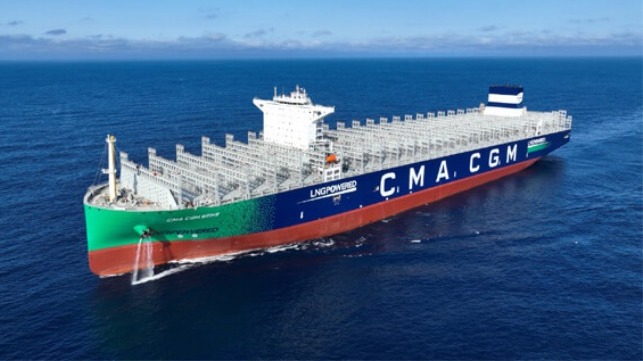
Image credit: The Maritime Executive.
Chinese officials recently highlighted the CMA CGM Seine as the world’s largest dual-fuel powered containership during its naming and delivery. The vessel, with a capacity of 220,000 dwt, is being described as both a “sea giant” and a “green cargo king” due to its advanced design and speed of construction.
The CMA CGM Seine shares dimensions with the five-year-old CMA CGM Jacques Saade class but boasts significantly improved efficiency. At 399 meters (1,309 feet) in length and 61.3 meters (201 feet) in beam, the ship is expected to reduce emissions by 20%, while nearly eliminating SOx and particulate matter. Its LNG-powered engines and 18,600 cbm MARK III LNG tank provide a range of 19,500 nautical miles. The vessel is also fully compliant with IMO Tier III standards.
Cargo handling has been further optimized, increasing capacity by about 764 TEU, bringing the total to 23,876 TEU, including 2,200 reefer slots. Boxes can now be stacked 24 layers high. Fire safety systems for cargo operations have also been upgraded. The ship competes with other 24,000-plus TEU vessels built in China.
Liu Xuedong, deputy general manager of Hudong-Zhonghua Changxing Shipbuilding, stated that construction time was compressed to 4–5 months, ahead of the usual schedule. The vessel was delivered over six months early, setting a new industry benchmark for cycle control.
The naming ceremony took place in Shanghai on April 15. The CMA CGM Seine will join the Far East to Europe route. It is the first of four new ultra-large vessels being built for CMA CGM.
Hudong-Zhonghua has delivered 17 containerships to CMA CGM, including 12 LNG-fueled vessels. The yard currently has 20 vessels under construction, with a $19.6 billion orderbook extending until 2029.
CMA CGM’s investment in LNG and methanol-powered ships continues, with nearly $20 billion committed. In 2024, the group took delivery of 12 new LNG vessels and plans to have 153 low-carbon ships in its fleet by 2029. The company currently operates around 670 vessels, with 100 more on order.
